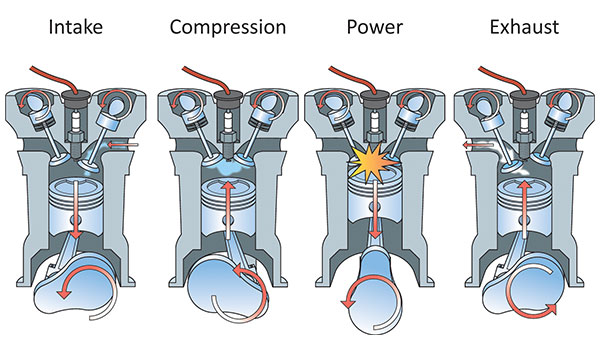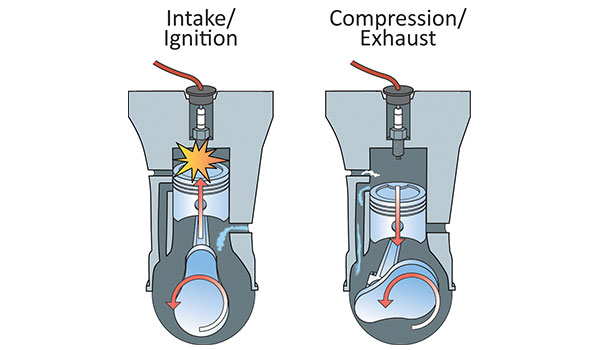I have had first hand experience with AMSOIL for years. It is the only oil I use in my Chevrolet Silverado with a Duramax Diesel, Honda Accord, Honda CRV, my beloved 32 Ford Roadster, Harley Davidson Street Glide, Polaris XPT, Toro zero turn, Honda snow blower, Yamaha Outboard, and Onan generator. Yeah I buy a lot of AMSOIL but they make it easy and I sleep well at night knowing I have great protection. Enjoy this article and remember Preferred Customers receive 25% off on all products and free shipping on all orders 100.00 or more. Shop now
2-stroke and 4-stroke engines operate under different conditions, requiring different lubrication methods.

Two-stroke and 4-stroke engines operate under different conditions, requiring different lubrication methods.
Internal combustion engines, whether 2-stroke or 4-stroke, convert the chemical energy contained in fuel into mechanical energy used to power a vehicle or other piece of equipment.
They accomplish this via the combustion event, which includes four distinct cycles: intake, compression, power and exhaust.
The engine draws air/fuel into the cylinder, compresses it in preparation for combustion, ignites it to produce the explosion that drives the piston down and, finally, expels the exhaust gases prior to starting the cycle anew.
The differences between 2-stroke and 4-stroke engines
Each upward or downward movement of the piston is called a stroke. The terms “2-cycle” and “2-stroke,” as well as “4-cycle” and “4-stroke,” are often interchanged. The fundamental difference between 2-stroke and 4-stroke engines is how they remove exhaust gases after combustion and introduce a fresh mixture for the next cycle.
Four-stroke engine chamber design
A 4-stroke engine uses intake and exhaust ports positioned at the top of the combustion chamber to achieve this. Intake and exhaust valves control the opening and closing of the ports to manage incoming and exiting gases. The intake port controls the incoming air that reacts with the fuel when ignited. The exhaust port carries burned gases out of the combustion chamber.
Four-stroke engine combustion cycle
The 4-stroke cycle requires two full revolutions of the crankshaft to complete the intake, compression, power and exhaust strokes. During the first revolution, the fuel-air mixture is drawn into the combustion chamber through the intake port and compressed. During the second revolution, the fuel-air mixture is ignited and the burned gases are released.

1. Intake stroke
As the piston moves down the cylinder, it creates a vacuum in the space above it and draws air into the cylinder through the open intake valve.
2. Compression stroke
The intake and exhaust valves are closed as the piston moves up and compresses the fuel-air mixture in preparation for combustion.
3. Power stroke
During the power stroke, both the intake and exhaust valves are closed as the spark plug ignites the fuel-air mixture. The explosion forces the piston down, turning the crankshaft.
4. Exhaust stroke
As the piston travels up, it forces the burned gases out through the open exhaust valve, preparing the cylinder for a fresh charge of air and fuel.
Shop AMSOIL Synthetic 4-Stroke Oils
Two-stroke chamber design
Two-stroke engine operation is much simpler because 2-stroke engines use ports on either side of the piston to control the gases that enter and exit the cylinder. The moving piston covers and uncovers the ports, much like the valves open and close in a 4-stroke engine.
Two-stroke engine combustion cycle
A 2-stroke engine requires only one revolution of the crankshaft to complete the combustion event. The engine fires every time the crankshaft revolves, doubling the number of explosions compared to a 4-stroke engine and generating more power.

1. Intake-ignition stroke
The intake port is open as the piston moves up. This creates a vacuum in the space below the piston, causing air to rush into the crankcase. As the air travels through the carburetor, it picks up a dose of fuel and oil.
As the piston continues up, the fuel-air mixture already in the cylinder is compressed. As the piston reaches top-dead-center (TDC), the spark plug ignites, causing the fuel-air mixture to explode.
2. Compression-exhaust stroke
The piston is forced down by the explosion of the fuel-air mixture. As the piston moves down, the burned gases are released through the exhaust port. The oil-fuel mixture in the crankcase is pressurized as the piston moves down and is forced through the transfer port into the cylinder. The incoming charge pushes out any remaining gas fumes from the cylinder.
Shop AMSOIL Synthetic 2-Stroke Oils
Two-stroke and 4-stroke applications
Another key difference between engine designs is that 2-stroke engines are less expensive to build, lighter and offer a higher power-to-weight ratio than 4-stroke engines.
For these reasons, 2-stroke engines are ideal in handheld applications like chainsaws, string trimmers and backpack blowers. Two-stroke dirt bikes are also making a comeback thanks to engine designs that produce reduced emissions and a more usable power band. Two-stroke engines are also easier to start in cold temperatures, making them ideal for use in snowmobiles.
Four-stroke engines, on the other hand, produce more torque at lower rpm, generally provided greater equipment durability than high-revving 2-stroke engines and also provide better fuel efficiency and lower emissions. For these reasons, 4-stroke engines are ideal in applications such as motorcycles, ATVs/UTVs, marine motors and personal watercraft.
Four-stroke lubrication
Four-stroke engines are lubricated by oil held in an oil sump. The oil is distributed through the engine by splash lubrication or a pressurized lubrication pump system; these systems may be used alone or together.
Splash lubrication is achieved by partly submerging the crankshaft in the oil sump. The momentum of the rotating crankshaft splashes oil to other engine components such as the cam lobes, wrist pins and cylinder walls.
Pressurized lubrication uses an oil pump to provide a pressurized film of lubricant between moving parts such as the main bearings, rod bearings and cam bearings. It also pumps oil to the engine’s valve guides and rocker arms.
Shop AMSOIL Synthetic 4-Stroke Oils
Two-stroke lubrication
Two-stroke engines collect some oil beneath the crankshaft; however, 2-stroke engines use a total-loss lubrication system that combines oil and fuel to provide both energy and engine lubrication. The oil and fuel are combined in the cylinder’s intake tract and lubricate critical components such as the crankshaft, connecting rods and cylinder walls.
Oil-injected 2-stroke engines inject the oil directly into the engine, where it mixes with the fuel, while pre-mix 2-stroke engines require a fuel/oil mixture that is combined before being installed in the fuel tank. In general, 2-stroke engines wear more quickly than 4-stroke engines because they don’t have a dedicated lubricant source; however, high-quality 2-stroke oil significantly reduces engine wear.
